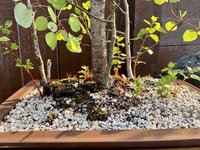ghues
Omono
Are there any?.......most of what I've read ......reviews the negative aspects of a tree being root bound. I've also learnt the hard was (RIP) what happens to trees that should have been repotted 2-3 years before it hit the wood pile.
However, I had always planned to dig up a few more Trembling Aspen(TA) "sticks" and make a grove/forest.....last spring I contemplated repotting the tree but I noticed a couple of suckers, so "what the heck" I thought I'd see what happens....there are now 4.
Maybe in a couple more years I'll have a little TA forest made from the mother tree which is exactly what it does naturally. I don't have to go far for TA inspiration.....see the large one above the fence....in the forest behind the house....still might dig a few and start another forest project lol.
Has anyone else got any root bound stories to share?
Cheers from the PNW.
Graham
However, I had always planned to dig up a few more Trembling Aspen(TA) "sticks" and make a grove/forest.....last spring I contemplated repotting the tree but I noticed a couple of suckers, so "what the heck" I thought I'd see what happens....there are now 4.
Maybe in a couple more years I'll have a little TA forest made from the mother tree which is exactly what it does naturally. I don't have to go far for TA inspiration.....see the large one above the fence....in the forest behind the house....still might dig a few and start another forest project lol.
Has anyone else got any root bound stories to share?
Cheers from the PNW.
Graham




